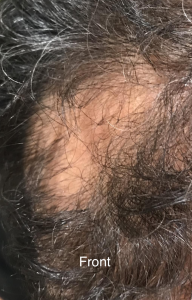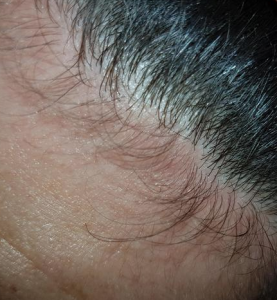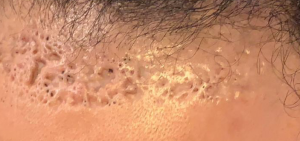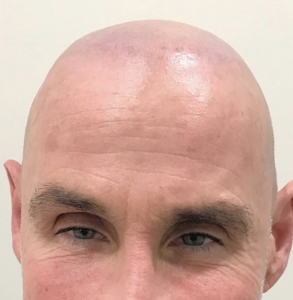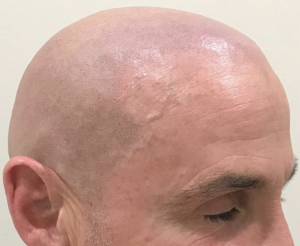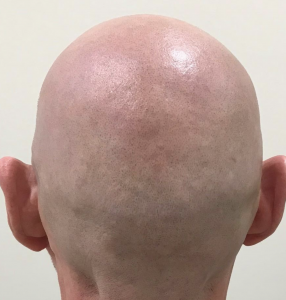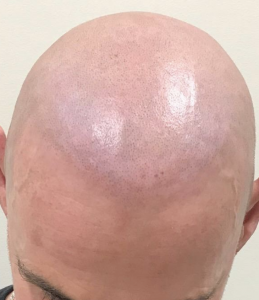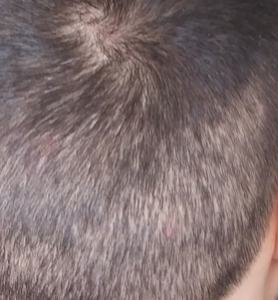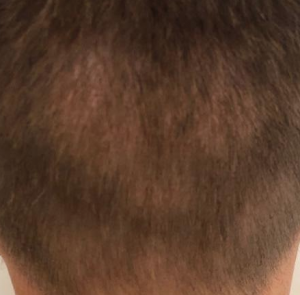This proves my point that young men (under 25 and especially under 20) have a higher benefit from taking finasteride than men over 25. Good job and stick to it and maybe you can avoid more hair loss for many years. The photo shows that the miniaturized hairs in the front seem to have become thicker ‘terminal hairs’ which are essentially normal growing hair.
Note: Article Warns of Variations in the Quality of These Drugs on the Market
Pharmacogenetic analysis of human steroid 5 alpha reductase type II: comparison of finasteride and dutasteride
Human steroid 5 alpha-reductase type II is a prostate-specific, membrane-associated enzyme that catalyzes the conversion of testosterone to dihydrotestosterone, the most potent androgen in the prostate gland. Genetic variants of this enzyme have been associated with both the development and the progression of prostate cancer. Both finasteride and dutasteride are competitive inhibitors of the type II steroid 5 alpha-reductase that have been effectively used for the treatment of benign prostatic hyperplasia. Finasteride has also been successfully utilized for prostate cancer chemoprevention. We here investigate 5 alpha-reductase inhibition assays in vitro to measure the effect of incubation time on the apparent inhibition constant (Ki) for both constitutional and somatic (prostate cancer) enzyme variants. Our systematic pharmacogenetic analysis shows that both finasteride and dutasteride are slow, time-dependent inhibitors of steroid 5 alpha-reductase type II, and that the inhibition kinetics depend on the 5 alpha-reductase genotype. We also show that, overall, dutasteride is a more efficient steroid 5 alpha-reductase inhibitor than finasteride. Based on our data, we are able to map areas of the enzyme that are responsible for this time-dependent inhibition for either (or both) enzyme inhibitor(s). This comprehensive pharmacogenetic analysis of steroid 5 alpha-reductase variants unveiled significant pharmacogenetic variation for both finasteride and dutasteride and thus should be taken into account when designing protocols for treatment and/or chemoprevention of prostatic diseases with either one of these 5 alpha-reductase inhibitors since there is considerable pharmacogenetic variation for both drugs.
Shedding after 2 years of being on finasteride usually indicates an acceleration of the genetic hair loss process for those with the genes for balding
Hair loss is progressive and this man shows why. He had a hair transplant 15 years ago in the frontal area (marked in the photo as front), and he lost hair behind the hair transplant. He is now 49, so he was 36 when he had his hair transplant. Had he been 25, it is likely that he would have lost it faster than 15 years, and if his final balding pattern was not defined, then he might have lost far more hair at 25. At the age of 36, hair loss usually slows down and the hair loss patterns are more stable.
Hi doctor, what do you think of this article? https://www.reuters.com/investigates/special-report/usa-courts-secrecy-propecia/
TLDR: The article indicates that Merck appears to have lied about side mental effects of this drug.
I have read the article previously. There is nothing to link finasteride to the change in behavior with absolute certainty. This type of change can happen in mental illness as well. This man should have stopped taking the drug with these side effects. His doctors should have been involved in his management. Many possible things could have happened that may have altered this person’s course.
UPDATE: There are two more studies that are concerning about post-finasteride syndrome and the mental side effects can be found here:
- https://www.ncbi.nlm.nih.gov/pubmed/32033719: The article states: “Also, increased depression, anxiety and suicidal ideation in a subset of men treated with these drugs were commonly reported in a number of studies”
- https://www.ncbi.nlm.nih.gov/pubmed/31935720: CONCLUSION: Men under the age of 40 who use finasteride for alopecia are at risk for suicide if they develop persistent sexual adverse effects and insomnia. Further research is needed to establish whether finasteride has a causal relationship to suicide.
The first sign of early recession might be miniaturized hairs that usually don’t grow to full length. I would see a doctor who can check your entire head with the HAIRCHECK test to find out if you are losing hair anywhere else. The hairs that don’t grow are most likely miniaturizing hairs that will eventually fall out and not regrow.
I got a hold of the operative note from the surgeon, and it was evident that the surgeon had taken out too much scalp and could not close the wound. The wound measured about 10 inches long and 2 1/2 inches high. When I first saw this patient, the wound was infected and draining. He had asked his surgeon why his wound smelled so bad and was told it was normal. After a few weeks a pus draining on his pillow, he found me and came to my office. I leveled with him from the start and put together a plan so he knew what would happen to him. I treated the open wound and the infection over a few months. It finally healed with this terrible-looking scar (something I expected and prepared the patient to expect). Working with Dr. Sheldon Kabaker, we placed a balloon expander in his head under the normal part of the scalp above the wound, stretched the scalp so that it would be able to cover this wound, and then, after 7 weeks of inflating the balloon twice a week in my office, we removed the scar and closed the wound. He looked great once it was completed with a barely visible wound. Unfortunately, he was ‘out of commission’ from a work perspective for about 5 months. He was a ‘high profile professor’ at a major university in Southern California and despite his education, he didn’t research his surgeon before selecting his initial doctor.
He ended up like he never had anything go wrong in the first place because when we fixed the scar, we also fixed his frontal hair transplant that were messed up by that same surgeon with hair we harvested from the expanded normal scalp. The take-home message here is: Make sure that the doctor you select for your hair reconstruction procedure is credentialed and experienced, and knows what he is doing. Strip hair transplants are safe surgeries when done in competent hands. I performed Balloon Expansion for this man and his scar was not detectable after the surgery. I had planned the expansion to be larger than I needed to correct the scar so that I finished the hair transplant he originally wanted done. When his surgery was complete, he had no visible scar and a full head of hair.
Thank you for your reply doctor! I live in Germany and the dermatologist, who prescribed me Finasteride, had many patients and is really not bad in terms of hair and so on. She said, that none of their patients experienced further loss.
My plan was to stabilize my hair loss with Finasteride 1mg and keep applying Minoxidil foam 5% on my hair line. I wanted to do a small 2k graft transplant in my hair line when I am 25 in order to make it more „even“. But it seems like I should ditch this idea because my hair loss does not stabilize.
Everyone who does a hair transplant has further progression of hair loss over time. The reason that they do a hair transplant, is that they want hair and don’t want a balding appearance! They used drugs like minoxidil and finasteride to prevent further hair loss, which can slow it down considerably. By the time you are 25, your pattern should be fully detectable, especially with a HAIR CHECK instrument, that is, if you can’t see the final pattern. A good Master Plan must be created with a very good doctor who understands planning (not just how to do a hair transplant). I like to show men this picture because it tells very nicely that hair loss is progressive and you don’t want to get surprised if this is you: https://baldingblog.com/need-master-plan-think-hair-transplants-photos/
Finasteride is known to decrease sperm count. Although, even with a low sperm count, you can get a woman pregnant. If there is a problem, get a sperm count if you are on finasteride.
In just 1 week, 3 states considered bills to ban discrimination based on hair texture or style

A national effort known as the CROWN Act seeks to ensure protection against discrimination based on hair texture and protective styles.
(CNN)In just one week, three states around the nation introduced or advanced bills that would ban hair discrimination.
The bills are part of a national effort known as the CROWN Act, which stands for “Creating a Respectful and Open World for Natural Hair” and seeks to ensure protection against discrimination based on hair texture and protective styles.
The Colorado state House passed the CROWN Act on Wednesday, and the state Senate introduced the bill on Thursday.
The same day, Washington state House passed a bill that would prohibit employers and schools from discriminating against people over hairstyles and textures including afros, braids, locks and twists. The bill was introduced in the state Senate on Friday.
The Minnesota bill introduced similar legislation earlier in the week.
The recent bills come after ‘Hair Love’s’ Oscar
The flurry of activity around these bills come as director Matthew A. Cherry won an Oscar for the short film “Hair Love,” a story about a black father trying to do his daughter’s hair.

Matthew A. Cherry won an Academy Award for best animated short for the film “Hair Love.”
In his acceptance speech, Cherry pushed for the CROWN Act to be passed around the nation.
“‘Hair Love’ was done because we wanted to see more representation in animation, we wanted to normalize black hair and there’s a very important issue out there, the CROWN Act. If we can help get this passed in all 50 states it will help stories like Deandre Arnold’s … stop to happen,” Cherry said.
Nearly two dozen states are considering action
The CROWN Act is already law in California, New York and New Jersey. At least 22 states are considering the legislation, and local jurisdictions like Cincinnati, Ohio, and Montgomery County, Maryland, have passed it too.
This week Texas lawmakers said they would consider the issue too. Members of the state’s Legislative Black Caucus announced this week that they were working on a bill for the 2021 legislative session, after an 18-year-old in the state was told to cut his dreadlocks or he wouldn’t be able to walk at graduation.
The legislation has also been introduced in Congress.
-
PAID CONTENT
When hair looks thin either density is low (number of hairs) or thickness of the hair decreases (miniaturized hairs reduce thickness as they eventually just become thread-like and disappear).
Struggled with aggressive hair loss since 19. Started the Big 3 in August 2016, and was a great responder after the initial 3 months shedding. After 2 years of being a thick NW2.5, in August 2018, I had a relatively big shed and expected this to grow back, but it didn’t. Instead I’ve seen my hair gradually thin out to baseline, and in the last couple of months below baseline. I’m currently a NW3 diffuse thinner, scalp just becoming visible under direct light when my hair is dry.
Would really appreciate advice for my next steps. Would getting my DHT level tested confirm whether fin has lost its effectiveness? If so, can anyone testify for gradually phasing dut into my regime until it replaces fin? Apart from slight loss of libido, I haven’t experienced sides on fin, but I am still afraid of starting dut at such a young age given the increased risk of problems.
The single best way to understand what is happening to you, is to build a Master Plan with a good doctor who specializes in hair loss. That doctor should start by establishing a base line with a HAIRCHECK test (https://baldingblog.com/haircheck-test-how-it-is-done-and-what-its-value/) , and then try various treatment modalities on your to find out what works bests. HAIRCHECK test follow-ups yearly tell how effective the treatments are. Eventually, some people can’t control the hair loss and end up as hair transplant candidates. A good doctor will not try to rush you into doing a hair transplant because he should treat you like one of his own ‘sons’– only recommending a hair transplant after you are 25 years old and have developed any significant balding.
Both of these young men had too many FUE grafts taken from their donor area and now, even with long hair, have what appears to be balding in the back of the head. Longer hair will help, but Scalp Micropigmentation (https://scalpmicropigmentation.com/scar-covering/) usually solves the appearance but doesn’t replace the missing hair in the donor area.
Page 232 of 635


